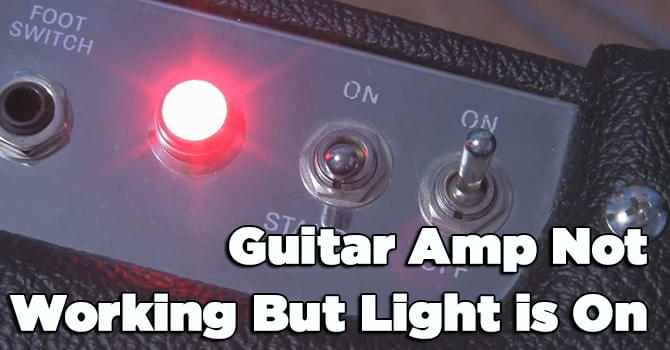Guitar Amp Not Working But Light is On [Quick Solution]
If you’re a guitarist, you know how frustrating it can be when your beloved amplifier suddenly refuses to make any sound, despite the power light indicating that it’s on. This issue is a common one and can arise from various sources, including faulty cables, speaker problems, or internal component issues. In this guideline, we will explore the most effective ways to troubleshoot and fix the “Guitar Amp Not Working But Light is On” issue.

# Table of Contents =>
Understanding Your Guitar Amplifier:
Before diving into troubleshooting, it’s crucial to understand the basic components of your guitar amplifier. An amplifier consists of several key elements, including:
Input Jack: Where you plug in your guitar.
Preamp: Amplifies the guitar signal.
Tone Controls: Adjust the EQ settings (bass, mid, treble).
Power Amp: Increases the signal to drive the speaker.
Speaker: Produces sound.
Indicator Light: Shows the amp’s power status.
When your amp’s light is on but no sound is coming out, it suggests that power is reaching the amp, but something is hindering the signal’s path to the speaker. Let’s explore potential solutions step by step.
Step 1: Check Your Cable and Guitar:

Swap Cables: Start by replacing the cable connecting your guitar to the amplifier. Cables can deteriorate or develop shorts, causing signal loss.
Try Another Guitar: Test your amp with a different guitar to rule out any instrument-related issues.
Step 2: Examine the Amp’s Front Panel:

Volume and Gain Controls: Ensure that these settings are adjusted appropriately, as extreme settings can cause silence.
Tone Controls: Check if the EQ settings are neutral (all knobs at 12 o’clock) and gradually adjust them while testing the sound.
Effects Loop: If your amp has an effects loop, make sure it’s not interfering with your signal. Try plugging your guitar directly into the amp.
Step 3: Investigate the Amp’s Back Panel:

Speaker Connection: Ensure that the speaker cable is securely connected to both the amp and speaker cabinet. Loose connections can lead to sound loss.
Fuse Inspection: Amps often have internal fuses. Check the amp’s manual to locate and inspect these fuses. Replace any blown fuses with ones of the same rating.
Output Selector: Some amps have multiple output options. Make sure the selector switch is set to the correct output.
Step 4: Internal Component Check:
Tubes: If your amp uses vacuum tubes, inspect them for signs of damage or wear. Replace any faulty tubes. Remember to follow safety guidelines when handling tubes.
Internal Wiring: If you’re comfortable with electronics, carefully open the amp and inspect the internal wiring for loose connections or broken components.
Conclusion:
In this comprehensive guide, we’ve explored various steps to troubleshoot and fix the “Guitar Amp Not Working But Light is On” issue. Remember that electrical components can be hazardous, so exercise caution when performing internal checks or tube replacements.
FAQs –
Q: Why is my guitar amp plugged in but not working?
A: Several reasons could cause this issue, including faulty cables, a blown fuse, or internal component problems. Troubleshoot step by step to identify the exact cause.
Q: How do you troubleshoot a guitar amp?
A: Start by checking cables, adjusting settings (volume, tone), inspecting the back panel (connections and fuses), and, if necessary, examining internal components like tubes or wiring.
Q: How do you fix a guitar amp that won’t turn on?
A: First, ensure it’s properly plugged in and the power switch is on. Check the power outlet and fuse. If those are fine and the amp still won’t turn on, consult a professional technician.
Q: How do I know if my guitar amp is blown?
A: Signs of a blown amp include no sound output, distorted sound, or unusual noises. If troubleshooting doesn’t resolve the issue, consider consulting a technician to assess and repair the amp.
Last Updated on September 21, 2023 by Perry Garner


